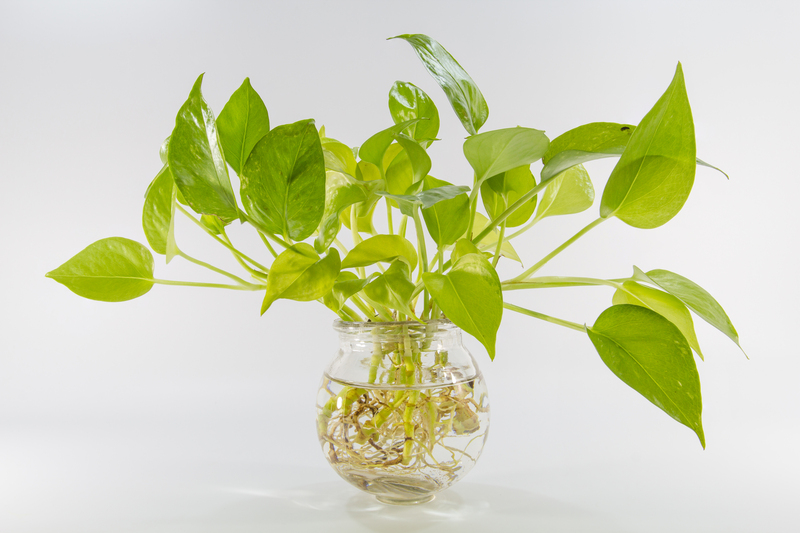Create a Weed-Resistant Garden with 3 Insider Tips
Posted on 15/06/2025
Create a Weed-Resistant Garden with 3 Insider Tips
Are you tired of endlessly pulling weeds and watching them keep coming back, no matter what you do? Establishing a weed-resistant garden isn't just a dream--it's an achievable goal with the right strategies. In this in-depth article, you'll discover three expert-backed insights to help you maintain a pristine, lush landscape while saying goodbye to invasive weeds. Whether you're an experienced green thumb or a gardening novice, these insider tips are your roadmap to a more beautiful, low-maintenance yard.

Why Focus on Weed Prevention?
Tackling weeds after they've taken root is a time-consuming and often futile battle. By focusing on weed prevention and resistance, you not only save time and energy, but you also promote the health of your desired plants. Weeds compete for water, sunlight, and nutrients, stunting the growth of flowers, vegetables, or shrubs. Implementing a weed-resistant landscaping strategy helps mitigate these issues at their source and fosters a thriving environment for your garden plants.
Understanding the Enemy: What Makes a Weed?
Weeds are simply plants growing where they aren't wanted. Many weed species are resilient and adapted to disturbed soils, making them tenacious invaders. They reproduce swiftly through seeds, runners, or rhizomes and can quickly outcompete less vigorous garden plants. Common invasive weeds include:
- Crabgrass
- Dandelion
- Bindweed
- Chickweed
- Johnson grass
By understanding their tenacity and the conditions under which they thrive, you can design a weed-resistant garden that actively suppresses their growth.
Insider Tip #1: Build a Dense, Healthy Plant Community
Why Dense Planting Discourages Weeds
The first, and perhaps most important, step toward a weed-resistant yard is to eliminate empty spaces where weeds can gain a foothold. Nature abhors a vacuum--bare soil creates the perfect opportunity for weeds to take root. Instead, opt for dense plantings of your preferred ground covers, flowers, or vegetables.
- Choose fast-growing ground covers: Plants like Vinca minor, Ajuga, or Thyme form thick mats that prevent weed invasion.
- Interplant vegetables and annuals: Mixing crops and flowers can decrease available space, naturally smothering weed seeds. Try companion planting techniques, such as growing lettuce under the shade of taller tomato or pepper plants.
- Opt for perennial beds: A mature bed of hardy perennials like Hosta, Daylilies, or Coral Bells can outcompete weeds for sun and nutrients.
Tips for Maximizing Coverage
- Space plants closer together than recommended on the label if you don't mind crowding for weed control, especially in non-edible beds.
- Stagger plantings or use a mix of tall, medium, and short species to maximize sunlight usage and block weed seeds from reaching the soil.
- Use living mulches: Sow low-growing herbs or clover between taller species to fill gaps and further boost your garden's weed resistance.
Dense planting doesn't just look beautiful; it serves as a strategic weed barrier. Over time, as your chosen plants mature, you'll notice fewer and fewer weeds sprouting in your backyard oasis.
Insider Tip #2: Master the Art of Mulching
How Mulch Makes Your Garden Weed-Resistant
Mulching is one of the most effective and accessible tools for a weed-free landscape. When applied properly, mulch acts as a physical barrier, blocking sunlight from reaching weed seeds and preventing their germination. It also conserves moisture, moderates soil temperature, and even adds organic nutrients as it breaks down.
Types of Mulch and Their Benefits
- Organic mulches: These include shredded bark, wood chips, straw, leaves, and compost. They enrich the soil as they decompose, though you may need to replenish them yearly.
- Inorganic mulches: Materials like gravel, pebbles, or landscaping fabric offer longer-lasting weed suppression and don't need yearly replacement, but they don't enhance soil fertility.
- Living mulches: Low-growing, spreading plants can be used as a living mulch. These provide all the benefits of traditional mulch while adding visual interest.
Mulching Best Practices for a Weed-Free Garden
- Apply mulch at the right depth: Aim for 2-4 inches of organic mulch. Too little won't block light; too much can suffocate your plants.
- Replenish mulch annually or as needed, especially after heavy rains degrade your layers.
- Keep mulch off stems and trunks: Leave a small gap around plant bases to prevent rot and discourage pests.
- Layer for extra resistance: Consider using both a weed barrier fabric and a natural mulch layer on top for difficult areas.
Tip: For vegetable gardens, use straw or pine needles to keep weeds down while maintaining an environment friendly to edible crops.
Insider Tip #3: Smart Maintenance and Early Intervention
Make Weeding Easier with Proactive Tactics
Even the best-laid weed-resistant gardening plans can't guarantee a 100% weed-free plot--nature is persistent. However, with a few smart maintenance routines, you can drastically reduce both the number and persistence of weeds in your garden.
- Attack weeds when young: Most weeds are easiest to pull or hoe when they're still seedlings. Make a habit of walking through your garden every week and removing any weeds before they mature.
- Water wisely: Drip irrigation or soaker hoses deliver water straight to plant roots while keeping surrounding soil dry, minimizing the conditions that favor weed growth.
- Avoid soil disturbance: Excessive tilling or digging brings buried weed seeds to the surface. Only disturb the soil when absolutely necessary.
- Install physical barriers: For garden edges, paths, or perennial beds, edging materials like metal, stone, or deep plastic can effectively block creeping weeds like Bermuda grass and bindweed.
Utilize Pre-Emergent Herbicides (Optional)
If you're dealing with persistent annual weeds and want a chemical-free approach, consider applying corn gluten meal--an organic pre-emergent that prevents weed seed germination. For those open to synthetic solutions, there are many pre-emergent herbicides that can be used with care in flower beds and walkways. Just remember:
- Read all labels carefully and follow application instructions.
- Never apply to areas where you'll sow seeds you want to sprout.
- Reapply as necessary, especially after heavy rains.
Compost Wisely and Sanitize Your Tools
- Hot compost: To avoid reintroducing weed seeds, make sure your compost pile gets hot enough (above 135?F) to kill them.
- Clean your tools: After weeding, sanitize your shovels, hoes, and gloves, especially if you've removed persistent species, to prevent spreading seeds or roots.
Bonus Tip: Choose Weed-Resistant Plants and Seed Mixes
Some plants crowd out weeds naturally thanks to vigorous growth or allelopathic chemicals that suppress competitors. For a truly low maintenance weed-resistant garden, consider:
- Pachysandra
- Liriope
- Creeping juniper
- Bigroot Geranium
- Catmint (Nepeta)
- Buffalograss (for lawns)
When planting lawns, look for weed-resistant grass seed blends that boast aggressive growth and minimal maintenance requirements.
The Long-Term Benefits of a Weed-Resistant Garden
- Reduced maintenance time and effort, letting you focus on the plants you love
- Healthier soil with less disruption from frequent digging or chemical use
- Improved curb appeal and landscape value
- A more sustainable, environmentally-friendly landscape

Frequently Asked Questions About Weed Control
Can I create a weed-proof garden?
While it is almost impossible to have a 100% weed-proof garden, following weed-resistant gardening techniques as outlined above will dramatically minimize the number of weeds and make them far easier to manage.
How often should I mulch for weed prevention?
Mulch should be replenished at least once a year, typically in spring. However, you may need to top it up more frequently if you notice thin spots or after heavy rain.
Are chemical weed killers safe for vegetable gardens?
When growing edibles, it's best to avoid synthetic herbicides. Instead, use organic mulches, manual weeding, and living groundcovers for a safe, weed-resistant edible garden.
What is the best time to weed my garden?
The best time to weed is after rain, when the soil is moist and weeds pull easily. Regular, early intervention prevents mature weeds from setting seed and multiplying.
Conclusion: Start Your Weed-Resistant Garden Today
Creating a weed-resistant garden doesn't require endless hours of backbreaking labor or heavy reliance on chemicals. By embracing dense plantings, mastering the art of mulching, and establishing smart maintenance habits, you can transform your landscape into a lush, weed-suppressing sanctuary. Every garden is unique, so don't hesitate to adapt these insider tips for your specific climate, soil type, and plant preferences.
With patience, planning, and ongoing care--even just a few minutes each week--you'll enjoy a thriving, weed-resistant yard that brings you joy, not frustration. Happy growing!
```


